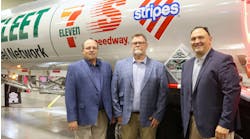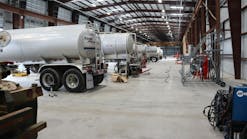The Federal Motor Carrier Safety Administration (FMCSA) in 2019 granted Groendyke Transport a five-year exemption to use amber brake-activated pulsating lamps on the back of its tank trailers to help prevent rear-end collisions.
The National Tank Truck Carriers’ (NTTC’s) 2020 exemption allows for amber or red lights.
So which color is best?
NTTC attempted to answer that question, and explore the ins and outs of the exemptions, the data behind them and ways to apply the rulings in carrier operations during the recent “Rear Brake-Activated Light Exemption” webinar.
The association also highlighted its preferred solution, which works without adding lamps.
Speakers included Larry Nilmeier, director of EH&S at Tankstar USA, who spearheaded NTTC’s exemption research and is leading the association’s testing of Intellistop’s light-pulsating module; Aaron Harmon, senior vice president of administration for Groendyke; and Michelle Hanby, CEO of Intellistop USA.
NTTC’s exemption
NTTC’s brake-activated pulsating lamp exemption granted Oct. 8, 2020, states: “During the temporary exemption period, motor carriers operating tank trailers will be allowed to install a red or amber brake-activated pulsating lamp in the upper center position or in an upper dual outboard position on the rear of the trailers, in addition to the steady-burning brake lamps required by the FMCSRs (Federal Motor Carrier Safety Regulations).”
The Agency granted the exemption from 49 CFR 393.25(e) after determining it “would likely achieve a level of safety equivalent to or greater than the level of safety provided by the regulation.”
Jerry Curl, director of operations at G&D Trucking/Hoffman Transportation, was one of the earliest supporters of the exemption, saying in his public comments “This should be something in place without question given the continued increase of rear-end and secondary crashes. The motoring public’s situational awareness is decreased traveling on interstates and anticipating traffic to be moving. Solid red brake lights are not easily detected with the high glow of LED lights. Pulsating lights increase your situational awareness and combat complacency. After studying these types of crashes for years, there must be an increase to lighting and signage.”
But Nilmeier said comments also revealed confusion about what is a “pulsating” lamp, and how it differentiates from a flashing light. Simply put, flashing lights turn off and on, while pulsating lights dim and brighten but remain on. More specifically, pulsating lights expand and contract rhythmically, like a heartbeat, and produce an “occulting” light similar to a lighthouse, so that the duration of light is longer than the total duration of darkness. “That’s opposite of a flashing light, where total duration of darkness is longer than duration of light,” Nilmeier said.
But what about the color of that light?
NTTC asked for and received the ability to utilize red and amber lamps, but Nilmeier said NTTC’s preference is red.
The former law enforcement officer pointed to differences in how the human eye perceives color. Amber has a wavelength of approximately 570 nanometers (nm), placing it in the middle of the visible light spectrum, which ranges from 400 to 700 nm. Red, with a length of 650 nm, is at the high end, allowing the eye to adjust quickly without harm, he said; and red-light exposure is associated with fewer traffic fatalities than blue or amber exposure, according to the National Highway Traffic Safety Administration’s Fatality Analysis Reporting System (FARS).
“Your high-frequency colors (like amber and yellow) emit higher energy values, that actually can draw too much attention, and hurt or blind the eye,” Nilmeier said. “Red is softer, and everybody knows red, since it’s already used in commercial vehicles, so it’s easily identifiable. I know something out of the norm is happening, or somebody is stopping.”
Groendyke’s exemption
Harmon said Groendyke picked amber to avoid confusion with emergency vehicles.
Their brake-activated pulsating lamp campaign commenced in early 2015. “Our senior leadership, including president Greg Hodgen, noticed this rash of rear-end accidents, and year-over-year it was a problem for Groendyke, as I’m sure it’s a problem for (others) as well,” Harmon said. “So (they) decided there’s got to be something we can do that will help raise awareness, and help bring this problem into control, and have less severity, less frequency. So we put a team together and started exploring solutions.
“First and foremost, we wanted to get the other driver’s attention, (to say) something’s going on, something is happening out of the norm. That was our primary goal. And then a close secondary goal was to make it highly visible. We wanted something you can see with peripheral vision, and that absolutely lets everyone know something is happening ahead of you.”
Ultimately, the Enid, Oklahoma-based carrier determined amber lamps mounted on a high, center section of its trailers best met those goals, so it began field testing—red lamps weren’t tested, Harmon said—and immediately saw benefits. After 30 months, and with nearly 632 of its 1,440 trailers converted, Groendyke reported a “drastic” 33.7% decrease in rear-end collisions—and 100% reduction in rear-end collisions at railroad crossings.
Harmon said they’d equipped approximately 850 trailers with brake-activated pulsating lamps as of January. “Unfortunately, we continue to have (rear-end collisions), but we keep chipping away at it,” Harmon said. “And everyday our goal is to improve and try to reduce the number of accidents we can’t totally control.”
However, Groendyke also drew unwanted attention from law enforcement during testing. “We had no intention of getting an exemption from the FMCSA,” Harmon noted. “All we wanted to do was create a safer environment for us and the motoring public. But as we continued to receive citations and violations, we consulted with NTTC and industry experts, and determined we needed an exemption because we saw this as a safer approach. We saw it was working, and we just needed support and buy-in from law enforcement.”
Groendyek’s application was published in the Federal Register in July 2018, and its exemption was granted in April 2019. “Since receiving our exemption, we’ve had no citations or violations,” Harmon attested. “So our field team was able to communicate to our drivers that we had an exemption, and our drivers have been able to communicate that with law enforcement.”
Safety improvement
Nilmeier said rear-end collisions come with myriad tangible and intangible costs carriers must bear. Tangible costs include truck, trailer and product damage; vehicle downtime; replacement staff training; disruptions in deliveries and schedules; and delayed shipments. Intangible costs include loss of life, which also negatively affects family and friends; diminished morale; customer disappointment and bad publicity.
Given the severity of those costs, NTTC wanted a solution adopters could deploy immediately that’s safe, effective and easily maintained, and selected Intellistop’s module because it doesn’t require installation of additional lamps and allows brake lights to maintain a steady burn if it fails. “It’s working,” Nilmeier said. “We haven’t had any problems with it. Law enforcement actually thought it was a really good idea, so we haven’t had any violations.
“If you’ve been hit by somebody, it takes you out of the game, and you lose equipment. But life is the most important thing we want to protect. And we’re not adding emergency lighting, or a bunch of extra lights, like chicken lights. We just want to develop a tool on the back that’s going to reduce rear-end collisions.
“At the end of the day, everybody deserves to go home.”
Intellistop system
Hanby knows carriers have questions. One she hears most involves placement, and she maintains as long as the pulsating lamp is above the dual outboard position, they’ll be fine. “(FMCSA) didn’t define a measured, specific location where you can have it,” she said. “So I don’t think you have to be concerned about that. There are so many different tank configurations, it leaves it open for you to do what works best for your company.”
What about utilizing existing brake or marker lights? “The exemption doesn’t state that you cannot use your lights,” Hanby said. “It almost coincides with the light placements that already exist on tank trailers. So it was left open to make it easier for each carrier to utilize what works best for them. You can add Intellistop and pulse your lights, or you can add additional lights.”
She also insisted carriers shouldn’t stress over citations when weighing risk vs. reward because “Groendyke took one for the team and got the word out.” However, they can help combat issues that may arise by educating drivers about the exemption, to help them better engage enforcement officers, and creating a document that references the exemption and details the company’s stance on improving road safety.
“Intellistop’s a module that you can add as an additional feature to your existing brake and marker lights, and it makes your lights multifunctional,” Hanby explained. “Intellistop’s design will pulse the lights while simultaneously maintaining the burn.
“When the truck driver applies the brakes in the truck, that braking signal goes through the truck’s pigtail into the trailer’s seven-way nosebox. Intellistop is installed in-line inside your nosebox, and it will pick up that brake signal coming on the existing brakes through the wire. And then it will modulate the voltage from 12 volts to 2.2 volts four times in about 2 seconds, and that sends that out to the brake and the marker outfit.”
Drivers can take their foot off the brake and reapply to reactivate the cycle as needed.
Installation takes less than 10 minutes, and the U.S.-made module includes a five-year warranty. “Your risk is pretty minimal,” Hanby concluded. “There is an exemption in place for you, and you should utilize it. You can reduce your accidents, reduce the damage to your equipment, reduce your downtime, and reduce the time you spend in litigation. But most importantly, the main goal for everybody is to reduce injuries and death.
“So take a moment to discuss it, weigh your options and find out what works best for you.”










